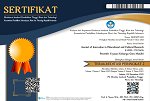Environmental Vision of Saija’s Characters in the Kelomang Novel by Qizink La Aziva
(1) Universitas Negeri Semarang, Indonesia
(2) Universitas Negeri Semarang, Indonesia
Abstract
In the current literary realm, literary texts that present natural destruction events implicitly or explicitly are called apocalyptic literature. The main characteristic of apocalyptic literature is the emergence of characters who have heroic characters. The Kelomang novel written by Qizink La Aziva was chosen because it is one of the novel texts that does not only make the environment the setting, but also makes the environment a part of the story. The story in the Kelomang novel is characterized by apocalyptic. This study aims to find the environmental vision of Saija's character in the Kelomang novel by Qizink La Aziva. This study uses an ecocritical approach to apocalyptic literature. The data source of this research is the text of the Kelomang novel by Qizink La Aziva published by PT Gramedia Pustaka Utama in Jakarta in 2016. The data in this study is a text fragment of the Kelomang novel by Qizink La Aziva which allegedly contains Saija's environmental vision. The result of this research is that Saija has a vision of the environment to save the environment from the increasingly severe impacts of environmental damage, especially in his area, namely Banten.
Keywords
Full Text:
PDFReferences
Adhikari, R. (2021). Anthropocentric Hubris and Ecological Reversal in JG Ballard’s The Drought. SCHOLARS: Journal of Arts & Humanities, 3(1), 94-102.
Afni, N. (2018). Representasi Alam dan Manusia dalam “Novel Api Awan Asap” Karya Korrie Layun Rampan: Suatu Kajian Ekokritik Gred Garrard. Universitas Negeri Makassar.
Anggraini, A. P. et.al. (2021). Sex in Stencil Novels Case Study: Reader’s Reception of Enny Arrow’s Stencil Novel in Surakarta. International Journal of Current Science Research and Review, 4 (1), 1-5.
Asri, Y. (2013). Refleksi Ideologi Wanita Minangkabau dalam Novel Negeri Perempuan Karya Wisran Hadi. Humaniora, 25(1), 69-81.
Chatterjee, N. (2021). Questioning the Notion of Speciesism in Select Poems of Peter Reading’s Faunal. Vidyasagar, 14, 178-186.
Garrard, G. (2004). Ecocrticism. New York: Routledge.
Glothfelty, C., & Fromm, H (eds). (1996). The Ecocriticism Reader: Landmarks in Literary Ecology. London: University of Georgia Press.
Handique, P., & Bhattacharyya, A. (2021). Re-understanding Deification and Hunger: An Ecocritical Venture into Shiva Purana. Journal of Humanities and Social Sciences Studies, 3(1), 116-121.
Hartavi, A. N. et.al. (2021). The Image’s of Javanese Women in The Novel “Panggil Aku Kartini Saja” by Pramoedya Ananta Toer. American Journal of Humanities and Social Science Research, 5 (1), 36-40.
Susanti, R., & Andriani, D. S. (2021, February). Building a Love Character of the Cultural Environment Through Historical Learning. In 1st International Conference on Character Education (ICCE 2020) (pp. 118-124). Atlantis Press.
Kaswadi. (2015). Paradigma Ekologi dalam Kajian Sastra. Paramasastra, 2 (2), 31-45.
Khristiyanti, D., & Supriyanto, T. (2018). Nature Environment Representation in Raudal Tanjung Banua Poetries: Exocriticism Review. Seloka: Jurnal Pendidikan Bahasa dan Sastra Indonesia, 7(2), 154-164.
La Aziva, Q. (2016). Kelomang. Jakarta: PT Gramedia Pustaka Utama.
Mishra, N. (2021). Ecocriticism and its Portrayal in Indian Fiction Writing. Journal of Literary and Cultural Analysis, 1(1), 7-11.
Putri, M. P. (2017). Realitas Sosial dalam Novel Kelomang Karya Qizink La Aziva (Kajian Realisme Sosialis Georg Lukacs). Bapala, 4(1), 1-11.
Rini, W. P. (2018). Paradoks Narasi Penyelamatan Keseimbangan Ekosistem dalam Novel Kailasa Karya Jusuf AN Kajian Ekokritik. Poetika: Jurnal Ilmu Sastra, 6(2), 122-132.
Sloots, A. (2020). An ecocritical approach to Kazuo Ishiguro’s “The Buried Giant”. Lund University, 1-18.
Sukmawan, S. (2013). Model-Model Kajian Ekokritik Sastra. PENSTRA, 2 (2).
Sulistijani, E. (2018). Kearifan Lokal dalam Kumpulan Puisi Kidung Cisadane Karya Rini Intama (Kajian Ekokritik Sastra). Nusa: Jurnal Ilmu Bahasa dan Sastra, 13(1), 1-15.
Supriyanto, T. (2014). Kajian Stilistika dalam Prosa. Yogyakarta: Elmatera Publishing.
Suryanto, S., Andayani, A., & Wardhani, N. E. (2021). Reflection of Character Education Value through Depictions of Characters in Oka Rusmini's Koplak Novel. International Journal of Multicultural and Multireligious Understanding, 8(2), 78-86.
Tait, A. (2021). Environmental Crisis, Cli-fi, and the Fate of Humankind in Richard Jefferies’ After London and Robert Harris’ The Second Sleep. Exchanges: The Interdisciplinary Research Journal, 8(2), 69-83.
Uniawati. (2014). “Nelayan di Lautan Utara”: Sebuah Kajian Ekokritik. Kandai, 10 (2), 246-257.
Yuniawan, T., Rokhman, F., Mardikantoro, H. B., Zulaehae, I., Yuwono, U., Prayitno, H. J., & Rohmadi, M. (2019). The function of eco-lexicons in conservation news texts published in mass media. International Journal of Innovation, Creativity and Change, 7(11), 301-313.
Refbacks
- There are currently no refbacks.
View My Stats

